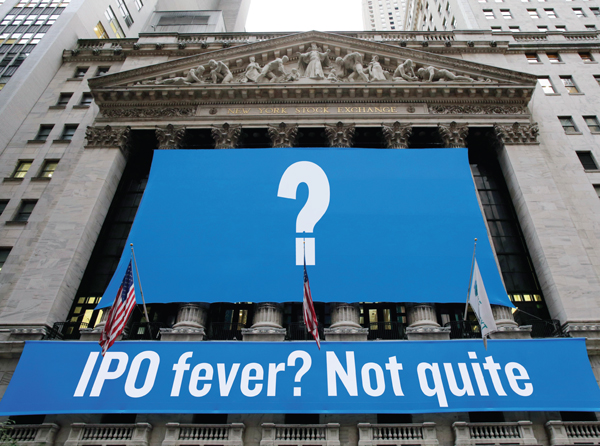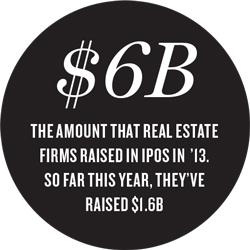 On the morning of February 10, landlord and investor David Bistricer rang the opening bell of the New York Stock Exchange, where, surrounded by family and colleagues from his firm, Clipper Equity, he ushered in another day of feverish trading. Afterward, Bistricer celebrated over a catered kosher breakfast and toured the historic building.
On the morning of February 10, landlord and investor David Bistricer rang the opening bell of the New York Stock Exchange, where, surrounded by family and colleagues from his firm, Clipper Equity, he ushered in another day of feverish trading. Afterward, Bistricer celebrated over a catered kosher breakfast and toured the historic building.
Meanwhile, on the trading floor, Clipper — the real estate firm founded in the 1950s by Bistricer’s father — had kicked off a new (and public) era. Two years after disclosing plans to go public, the company debuted on the exchange that chilly February morning under the ticker CLPR and at $13.50 a share.
So far, Clipper’s [TRDataCustom] calculus appears to have paid off: The company’s IPO generated $86 million — more than the $78 million Clipper had projected in regulatory filings.
At the time, the move was in sync with predictions that 2017 would see a burst of IPO activity in the real estate sector.
But those predictions were fueled, at least partly, by the fact that global IPO activity plummeted last year to its lowest levels since the financial crisis. That left many to believe the market was due for a bumper crop of IPOs because of pent-up investment demand.
Related: Tech darlings are different
In 2016, deal volume was down 36 percent to 112 IPOs, and the amount of capital raised sank 37 percent to $21.3 billion, according to research from accounting giant Ernst & Young.
Despite the predictions that 2017 would represent a turnaround, activity has been lukewarm— at least so far.
While there’s no shortage of rumors and plans for IPOs, there’s been more talk and less action this year.
Real estate IPOs peaked in 2013, when 21 companies raised more than $6 billion in initial public offerings, according the Greenwich-based Renaissance Capital, which specializes in providing pre-IPO research and managing IPO investments.
Among them were Empire State Realty Trust and the shopping-center mega-landlord Brixmor Property Group, which raised $929.5 million and $825 million, respectively. That came on the heels of the $1.08 billion public debut of Realogy Holdings — the parent company of the Corcoran Group, Citi Habitats and a slew of other residential firms — in 2012.
Kathleen Smith, a principal at Renaissance, said with interest rates so low, real estate investment trusts were attractive to investors because the companies could borrow money on the cheap. With such strong investor demand, going public was a smart way of “finding returns.”
“As interest rates rise, it reduces the economics of a REIT for investors,” said Smith.
 And as the Federal Reserve began raising interest rates in 2015, the number of real estate companies going public has indeed fallen precipitously. Last year, just four REITs nationwide went public.
And as the Federal Reserve began raising interest rates in 2015, the number of real estate companies going public has indeed fallen precipitously. Last year, just four REITs nationwide went public.
So far this year, there’ve been three — Clipper, the small financial Connecticut-based firm Sachem Capital Corp. and Invitation Homes, a Blackstone-backed REIT. Those three REITs have raised a combined $1.6 billion — a modest gain from the $1.5 billion raised in all of 2016 and $1.1 billion raised in 2015.
Rumors are undoubtedly swirling about real estate tech companies like home-sharing giant Airbnb and venture-backed residential brokerage Compass going public (see sidebar). Commercial brokerages, including Cushman & Wakefield, have also flirted with the idea. And Newmark Grubb Knight Frank has filed initial paperwork with the U.S. Securities and Exchange Commission to go public this year, as has KKR, which is looking to raise up to $100 million for a mortgage REIT focused on commercial debt.
Meanwhile, Vornado Realty Trust is working through plans to spin off its Washington, D.C., holdings and merge that portfolio with landlord JBG Companies. The combined company, to be called JBG Smith Properties, would be valued at $8.4 billion, including debt.
Still, sources say the pipeline and trajectory of REIT IPOs is uncertain.
They note that some companies that were considering IPOs are now wrestling with timing — given the slightly higher interest rates and low valuations in the market. And an increasing number of public companies are even considering going private.
For those weighing whether to go public, the decision is further complicated by the fact that a REIT index launched last year hasn’t resulted in the deluge of investment from general investors that analysts predicted. In addition, REIT values are trading around — or below —their book value.
“In 2017, public real estate valuations have generally declined relative to other parts of the market,” said Edward Mui, an analyst at investment research and management firm Morningstar. “Right now, the REIT sector is in a wait-and-see mode,” Mui added.
Fueling market share
In the clubby brokerage world, access to capital goes hand in hand with size and market share.
The commercial brokerage world in New York, and beyond, is now controlled by a handful of giant companies that have bought out firms over the past couple of years.
Anthony Paolone, an analyst at JPMorgan, said creating these megafirms — which can more easily move into new markets and launch new business lines — helps “achieve that goal of being in the top of the pack.”
And that, sources say, lays the groundwork for a successful IPO.

Tony Malkin
This year, Howard Lutnick’s BGC Partners — NGKF’s parent company — took the first steps to spin off the brokerage into its own public company. The move came about five years after BGC bought NGKF, a move that boosted its own stock price.
While NGKF’s investment-sales performance in New York has been less than stellar — it racked up $522 million in deals in 2016, taking the No. 18 spot on The Real Deal’s latest ranking of firms — executives have touted the company’s overall jump in revenue and brand-name poaches in other cities since the acquisition.
Meanwhile, Cushman & Wakefield has appeared to be heading toward a public offering since its $2 billion merger with Chicago-based brokerage DTZ, which is backed by the private equity firm TPG. In 2014, the firm paid $100 million to acquire Massey Knakal Realty Services, and last year it poached top dealmakers Doug Harmon and Adam Spies from Eastdil Secured.
“In Cushman’s case, I would assume, because it’s private equity-backed, that ultimately they’ll need to do something,” said JPMorgan’s Paolone, explaining why Cushman may be facing pressure to hit the stock market bell.
In January, Bloomberg reported that Cushman executives were talking to investment banks about going public, as early as 2017’s third quarter or as late as 2018.
“The stars have to be aligned correctly when you do this,” John Cushman III, the company’s chairman of global transactions, told TRD last year. “The economy has to be right. The real estate world has to be right.”
JMP Securities’ Mitch Germain — who agreed that a Cushman IPO is “on everyone’s radar” given its recent hiring and growth — said going public makes sense for some large companies because it gives them “dry powder to invest in the future growth of the company.”
But there are those who question whether brokerages today can attract investor capital.
“You can take anything public, but you may not be able to take it public for the price you think is fair,” said Brandon Dobell, an analyst at global investment bank and asset management firm William Blair.
These days, shares of publicly traded CBRE and JLL are trading low. JLL stock closed at about $112 on April 24, down from about $178 in July 2015. CBRE’s stock, meanwhile, dropped to $34.7 from $38 during the same time.
“With the potential slowdown in the real estate markets,” said Jahn Brodwin, a senior managing director at New York-based consulting firm FTI Real Estate Solutions, “who would want to buy into a brokerage business?”
T is for trillion
Despite buzz around the REIT index — a newly formed category of stocks that was expected to drive more general investors into real estate — its existence has done little to move the needle.
“There was a view that this would create lots of flows into the REIT market, because generalist investors — not REIT-dedicated investors — would have to get more market weight in the real estate business,” Owen Thomas, CEO of Boston Properties, said at NYU Schack Institute of Real Estate’s annual REIT symposium in April. “Well, that has not happened.”
 Before the index launched on September 1, JPMorgan predicted investors could pump as much as $100 billion into the sector.
Before the index launched on September 1, JPMorgan predicted investors could pump as much as $100 billion into the sector.
Real estate companies looking to grow recognize that shareholders can juice their earnings. And those who have gone public recently seem to have no rejects.
Clipper’s Bistricer determined that the trade-off of giving up its very private status — something many of New York’s old-school landlords and developers want to avoid — was worth it.
“It’s permanent capital,” he told TRD this year in describing his decision. “You can invest long-term, and it gives you more flexibility.”
That’s not true with private equity money, because lenders typically want to see returns within five to seven years, said Bistricer, whose public filings revealed that the company is planning to invest $31 million in its 3,500-plus-unit residential portfolio and aiming to generate an extra $7.1 million in rental income at 50 Murray Street and 53 Park Place in Tribeca after raising rents to an average of $80 per square foot from $68 per square foot. (Clipper’s stock closed slightly down at $11.07 a share on April 21.)
Meanwhile, Empire State Realty Trust CEO Anthony Malkin initially took heat for selling shares at $13 — the low end of the expected range. But Malkin said the decision was a good one.
“The market is perfect: It tells you what you’re going to get on the basis of what people are going to pay. You have to make a decision about whether you’re prepared to sell,” said Malkin.
“People had a hard time figuring out the value we’d be able to create by redeveloping the properties and leasing them to better tenants at higher rents,” he added.
But he pointed out that investors who bought during the REIT’s 2013 IPO have been rewarded with a roughly 78 percent return. (Shares closed above $21 in mid-April.)
“I’m perfectly happy with the result we achieved for our investors. We gave people liquidity without the requirement that they liquidate,” Malkin said.
But he noted that not all companies can pull it off. “If you’re too small, it’s not just the burden of reporting, it’s also the costs,” said Malkin. “You do need a certain size in order to attract institutional investors and funds.”
When a company is a fit, however, institutional investors still seem to be lining up.

Joanthan Gray
Overall, the industry’s market cap — or total value — surpassed $1 trillion this past July, up from $440 billion a decade ago, according to the National Association of Real Estate Investment Trusts, which represents REITs nationwide.
And while the index might not be surpassing expectations, some are confident that the tide will turn soon.
In recent months, strong fundamentals like high occupancy rates for REIT-owned properties have boosted share prices — which in March were up 8.6 percent year over year.
And there are other positive signs in the REIT market.
Calvin Schnure, NAREIT’s senior vice president for research and economic analysis, said secondary offerings — or new stock issuances from companies that are already public — are actually up. REITs raised $8.9 billion during the first quarter of the year, up from $6.6 billion a year ago. That, he said, could be a sign of things to come.
“I wouldn’t be surprised if you saw more IPOs, just because the underlying property fundamentals remain favorable,” he said.
Pull of privatization
Not everyone is convinced, however, that the IPO pipeline is going to get fatter anytime soon.
Jonathan Gray, the head of global real estate at private equity giant Blackstone, predicted a wave of privatizations.
Blackstone — whose $1.54 billion Invitation Homes IPO in January is the year’s only blockbuster deal so far — is now looking to raise $5 billion from investors for a new private Blackstone Real Estate Income Trust.
The private fund is part of Blackstone’s bet on less risky, income-producing assets — an area that it sees as having big potential.
“The prospects for growth in that business are huge,” CEO Stephen Schwarzman said on an April earnings call, referring to less-risky investments. “We should be able to create a really very large-scale business.”
At the NYU conference, Gray added: “My gut is there will be more privatizations.”
Historically, privatization is more prevalent when REIT prices are depressed, said FTI’s Brodwin.
In particular, companies with large capital needs tend to fall out of favor on the public market because REITs are required to pay dividends.
Brodwin said “privatization becomes more prevalent” when investors have cash to spend and interest rates inch up.
JPMorgan’s Paolone said REITs are currently trading within 5 percent of their “net asset value” — meaning their book value versus stock price. That relatively neutral position means that investors are not really being pushed hard in one direction over the other.
Brodwin said the market is currently at a “stalemate” with a dearth of activity for both public and private offerings.
“We’re kind of at the top of the roller coaster,” he said. “We’re teetering, and I’m not sure which way it could go. It could work itself into a bear or a bull.”
